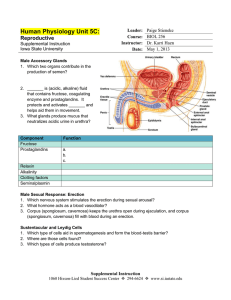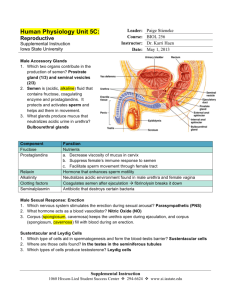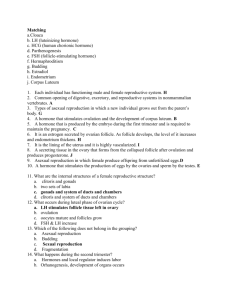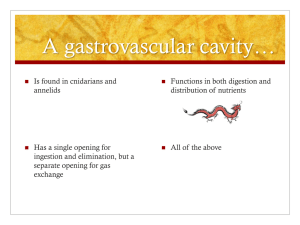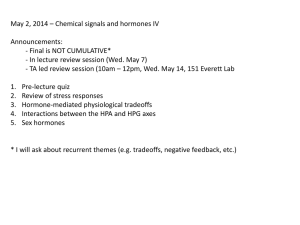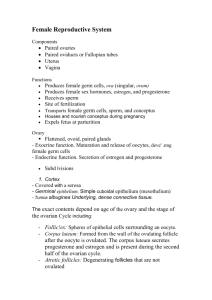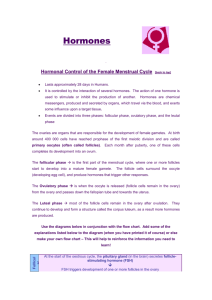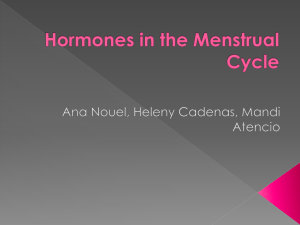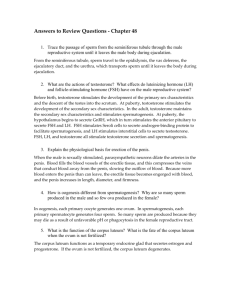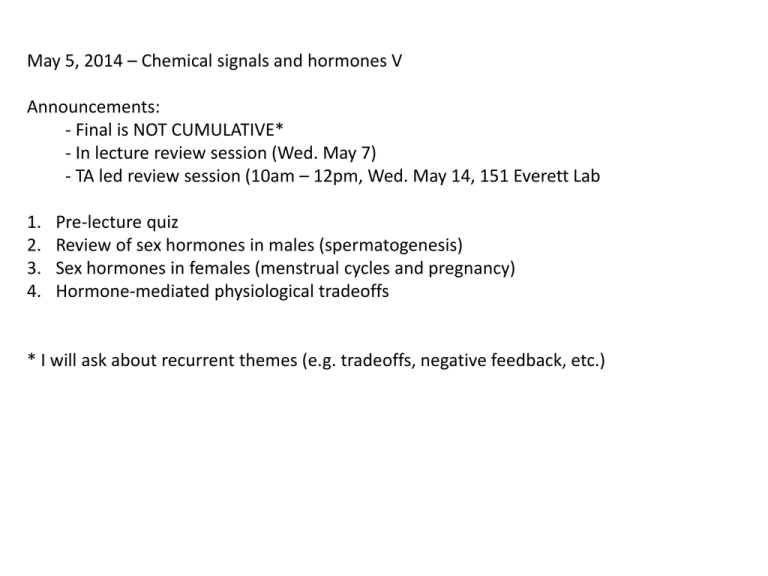
May 5, 2014 – Chemical signals and hormones V
Announcements:
- Final is NOT CUMULATIVE*
- In lecture review session (Wed. May 7)
- TA led review session (10am – 12pm, Wed. May 14, 151 Everett Lab
1.
2.
3.
4.
Pre-lecture quiz
Review of sex hormones in males (spermatogenesis)
Sex hormones in females (menstrual cycles and pregnancy)
Hormone-mediated physiological tradeoffs
* I will ask about recurrent themes (e.g. tradeoffs, negative feedback, etc.)
True or False: All mammals are
viviparous
• A.) True
• B.) False
Upon fertilization and implantation, the
degeneration of the corpus luteum is slowed by
which hormone in human females?
• A.) LH
• B.) Estradiol
• C.) Progesterone
• D.) human chorionic gonadotropin hormone
(hCG)
Hormone-mediated Tradeoffs
Interactions between stress, reproduction and immune function
HPG axis
Gonads
• Male testes produce sperm cells
• Female ovaries produce ova
• Fertilization
– Sperm cell + ovum = zygote
• Sex chromosomes
– Humans: XX = female, XY = male
– Birds: ZW = female, ZZ = male
– Many vertebrates lack sex chromosomes entirely
Sex Hormones – Released by Gonads
• Androgens - e.g., testosterone (“male” hormones)
• Estrogens - e.g., estradiol (“female” hormones)
• Adult testes release more androgens and ovaries more
estrogens
• Progestins – also present in both sexes
– progesterone prepares uterus and breasts for pregnancy
• Adrenal cortex – also releases sex steroids
HPG axis & Reproductive System
Males
Also known as Leydig cells
HPG axis & Reproductive System
Males
Females
Figure 48-12
5. Degeneration of
corpus luteum
Secondary oocyte
to oviduct
4. Ovulation
Oocytes
Follicle
cells
3. Maturation of
follicle
1. Formation of primary
oocytes within follicles
2. Follicle growth
Figure 48-13-2
FOLLICULAR PHASE
Follicle growth
LUTEAL PHASE
Ovulation
Corpus luteum degeneration
Pituitary
hormone
cycle
Hormone levels
Ovarian
cycle
LH
FSH
0
7
14
Days
21
28
Figure 48-14
FOLLICULAR PHASE
LUTEAL PHASE
Ovulation
Follicle growth
Corpus luteum degeneration
Progesterone
Estradiol
Low
Estradiol
inhibits
LH
release
Positive
feedback
on LH
Negative
feedback
on LH,
FSH
Figure 48-13
FOLLICULAR PHASE
Follicle growth
LUTEAL PHASE
Ovulation
Corpus luteum degeneration
Pituitary
hormone
cycle
Progesterone
Estradiol
Hormone levels
Ovarian
hormone
cycle
Hormone levels
Ovarian
cycle
LH
Menstrual
(uterine)
cycle
Thickness of
uterine lining
FSH
Menstruation
0
7
14
Days
21
28
Tons of Variation among Females.
Kathryn Clancy
UI - Anthropology
kclancy@illinois.edu
Pregnancy & hormonal arrest of the
menstrual cycle
• Human Chorionic gonadotropin Hormone
(hCG)
– Secreted by the developing embryo
– Slows corpus luteum degeneration
– Causes the ovary to continue secreting
progesterone, arresting the menstral cycle
• At later stages of the pregnancy, the placenta
also secretes high levels of progesterone
Steps of Hormonal Control of Ovarian Cycle
1.
2.
3.
4.
5.
GnRh released from hypothalamus. Stimulates release of FSH/LH in ant. Pit.
FSH (and to a lesser extent LH) stimulates growth of follicle cells.
Follicle cells release E.
Low levels of E have negative feedback on GnRH, LH, FSH . . But follicle cells keep growing.
Follicle cells get big release lots of E
-- positive feedback E has a positive effects on GnRH and LH
6. Hormone surge in LH, FSH, and E. Follicle bursts ovulation
7. burst follicle turns into corpus luteum. It secretes lots of progesterone and some estrogen.
8. increased progesterone causes thickening of endometrium.
9. P and E have a negative feedback on GnRH, LH, and FSH
10. corpus luteum degrades over time (provided no fertilized embryo)
11. P and E drop and the endometrium lining degrades (menstruation)
12. If fertilization, embryo secretes chorionic gonadotropic which maintains corpus luteum
(acts like LH) and maintains high levels of P. The endometrium is maintained. The placenta
develops and secretes high levels of P.
Hormone-mediated Tradeoffs:
Interactions between stress, reproduction and immune function
Video 1
Testosterone treated
Control
Territory size
Larger
Smaller
Singing frequency
Higher
Lower
# of aggressive interactions
Higher
Lower
Number of matings
Higher
Lower
Number of offspring
Higher
Lower
Offspring quality
Lower
Higher
Survival
Lower
Higher
Video 2
Montane
Urban
Breeding season
Shorter
Longer
Aggressiveness
Higher
Lower
Male parental investment
Lower
Higher
Testosterone
Higher
Lower
Cortisol
Higher
Lower
Stress response
Higher
Lower
Casto JM, V Nolan Jr., ED Ketterson. 2001. Steroid hormones and immune
function: experimental studies in wild and captive Dark-eyed Juncos. American
Naturalist 157:408-420.
Testosterone treated
Measured:
Control
1.) Corticosterone (= Bird cortisol)
2.) Innate Immune function (PHA injection and
swelling)
3.) Adaptive Immune function (antibody production)
Increased testosterone is associated with elevated levels of stress hormones & a reduction
in immune function
Testosterone treated
Control
Loss of winter fat stores
Sooner
Later
Cortisol
Higher
Lower
Stress Response
Higher
Lower
Innate immune response
Lower
Higher
Antibody production
Lower
Higher
Survival
Lower
Higher
In adult humans, females typically
exhibit a more pronounced antibody
response to vaccination. Why might
this be?
Why might it be beneficial to vaccinate
boys when they are young?
1.) Females exhibited greater antibody and cytokine production following flu vaccination
2.) Antibody production was negatively associated with testosterone levels in males.
3.) Reduced immune response in males was associated with changes in the regulation of
genes involved lipid metabolism and biosynthesis.
Video 1
Testosterone treated
Control
Territory size
Larger
Smaller
Singing frequency
Higher
Lower
# of aggressive interactions
Higher
Lower
Number of matings
Higher
Lower
Number of offspring
Higher
Lower
Offspring quality
Lower
Higher
Survival
Lower
Higher
Effects of cortisol on immune function
Cortisol negatively impacts:
- T-cell proliferation and signaling
- Leucocyte proliferation and the
inflammatory response.
- Development of immune system
structures (i.e. thymus)

